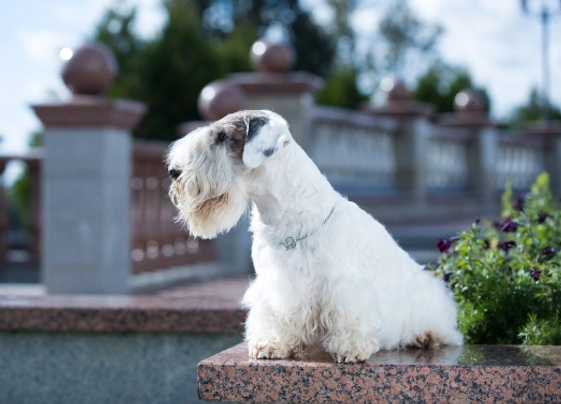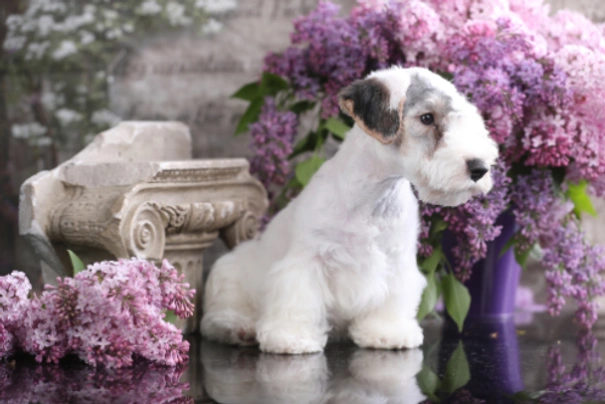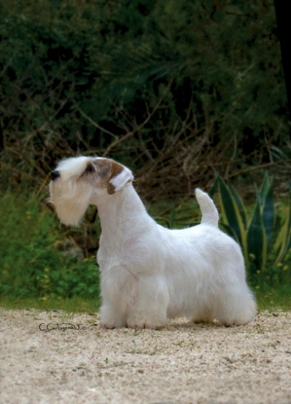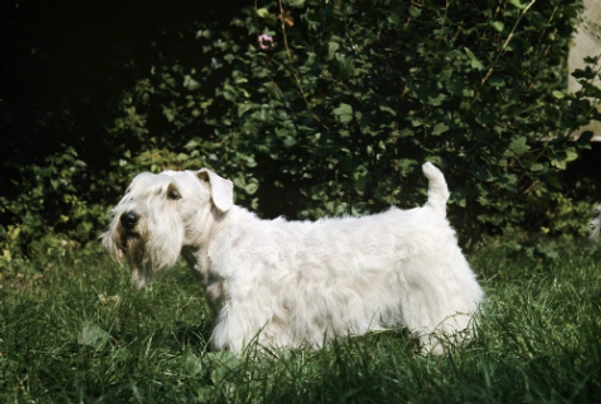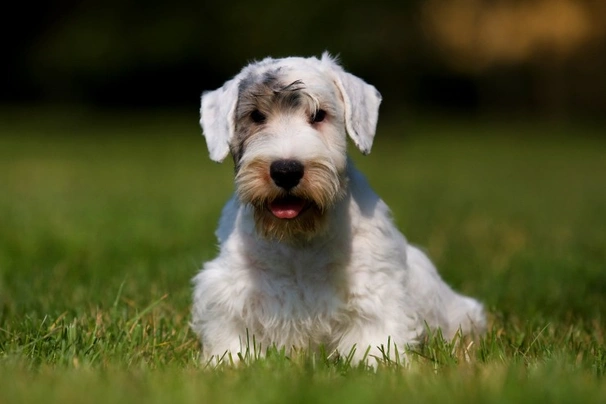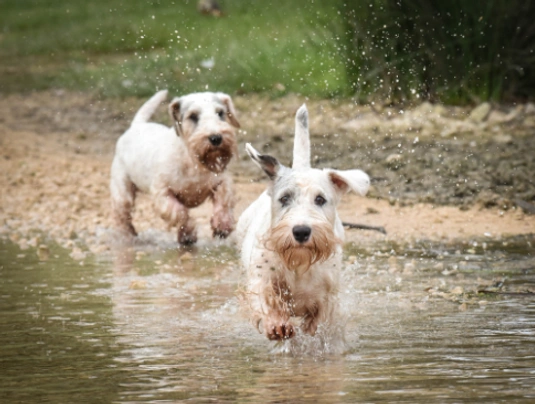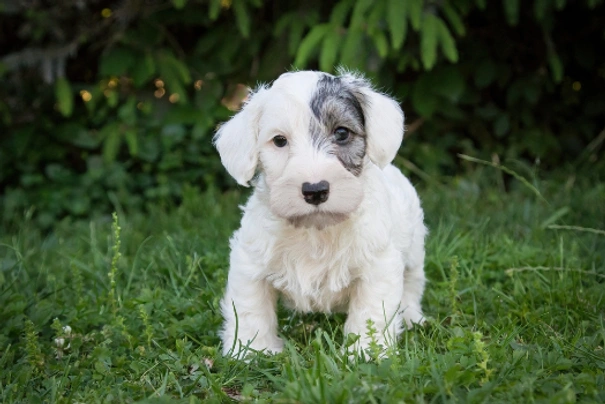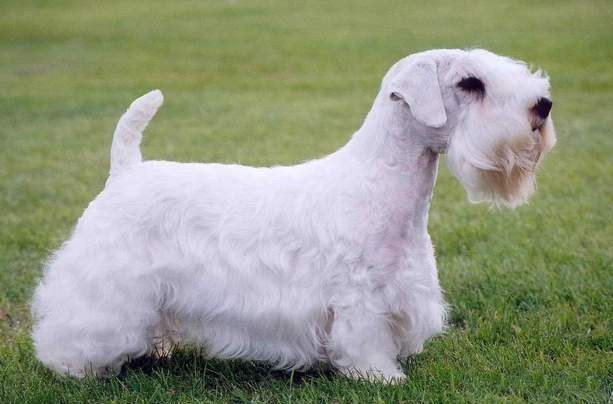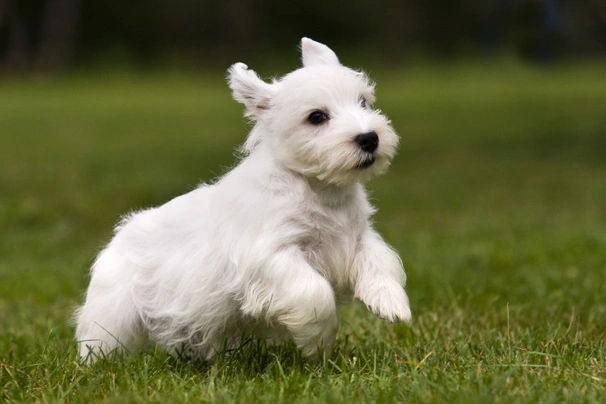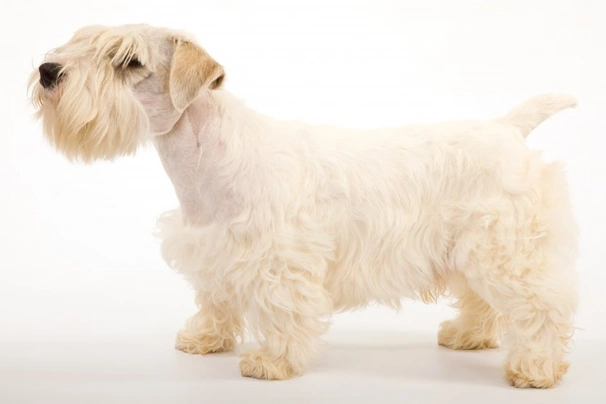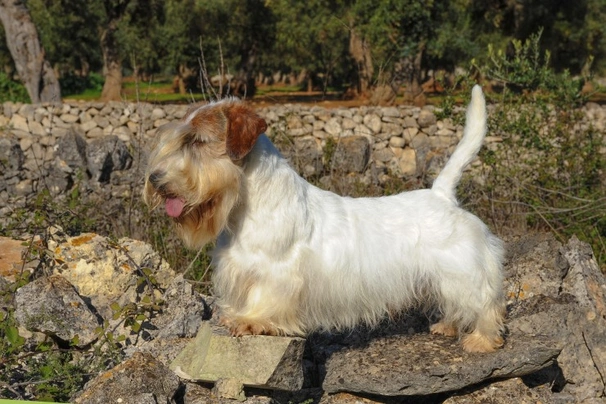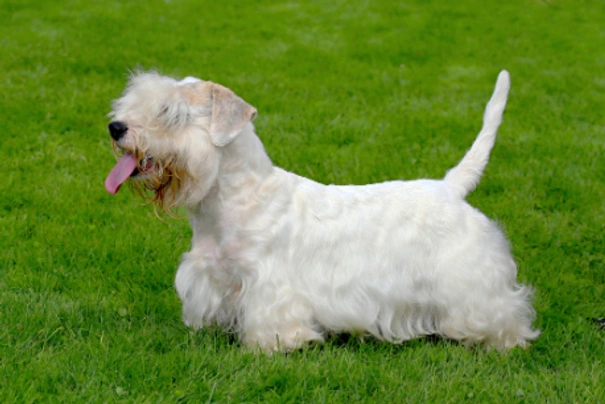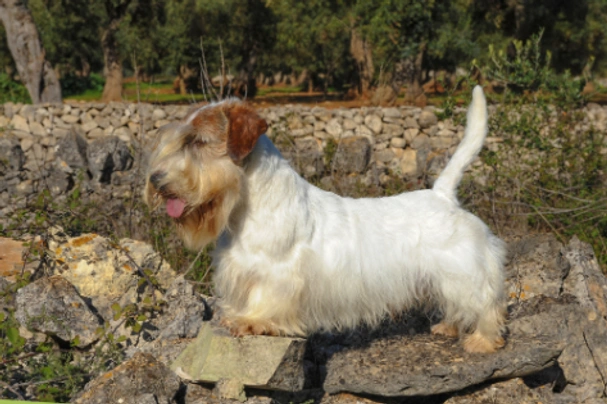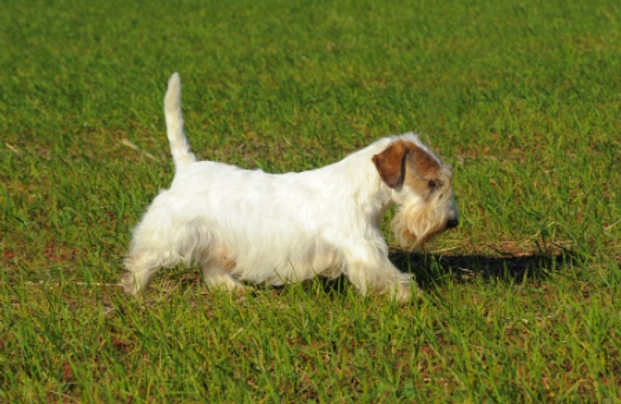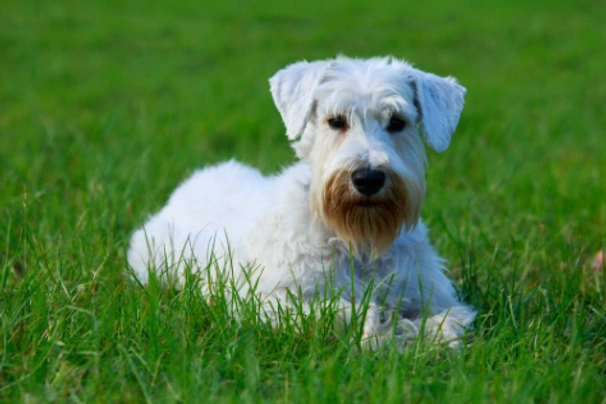Sealyham Terrier
Pros
Cons
Introduction of the Sealyham Terrier
The Sealyham Terrier is a charming little dog but unfortunately their numbers have fallen so low they have been placed on The Kennel Club's vulnerable native breeds list. They are short-legged and long in the body being native to Wales where they were developed by crossing Bull Terriers with West Highlands Welsh Corgies Dandie Dinmonts and Wire Fox Terriers. Sealies were bred to hunt but they are also known to be wonderful companions and family pets thanks to their loyal and devoted natures. However anyone wishing to share their homes with a Sealyham Terrier would need to register their interest with breeders for the pleasure of doing so.
History of the Sealyham Terrier
The Sealyham Terrier was first bred by Captain John Edwards who was a very keen huntsman during the 19th century and he spent over 40 years developing the "perfect" hunting dog on the Sealyham estate which is located close to Haverfordwest and Fishguard. They were bred to hunt badgers otters and foxes which they proved to be extremely good at. Dogs needed to be small enough to "go to ground" after their quarry and they had white coats so the hounds would not mistake them for their prey and the result of the Captain’s efforts proved to be just that.
It is thought he used Welsh Corgis the now extinct Cheshire Terrier small white Bull Terriers Dandie Dinmonts Fox Terriers West Highland White Terriers and other terrier-types to create his breed and the result of his efforts are the small white dogs we see today which are named after the Captain's estate Sealyham. Sadly he did not keep any records of his breeding programme. However a club dedicated to the breed was founded in 1908 and Sealyhams were recognised by The Kennel Club two years later in 1910. However very little breeding was done during the First World War and it was not until the 1920's that the breed gained popularity in the UK which led to a decline in good breeding practices which affected a Sealyham's temperament.
This changed at the end of the Second World War and once again good breeding practices saw a rise in the breed's popularity again which included in the United States more especially among celebrities. One of the biggest fans of the breed in the UK was Princess Margaret but sadly over the years breed numbers were seen to fall with very few puppies being registered with The Kennel Club every year and as such they have been placed on the list of vulnerable native breeds. Today anyone wishing to share their home with a Sealyham Terrier would need to register their interest with breeders and agree to being put on a waiting list for the pleasure of doing so.
Interesting facts about the breed
- Is the Sealyham Terrier a vulnerable breed? Yes breed numbers remain low and very few puppies are registered with the Kennel Club every year which means Sealyham puppies can be expensive and anyone wishing to share a home with one would need to register their interest with breeders first
- Famous owners include Gary Cooper Jane Russell Elizabeth Taylor Alfred Hitchcock an Cary Grant
- They are known to be a lot calmer than many other terrier breeds
- Traditionally a Sealyham Terrier's tail was always docked but since the law banning the procedure came into effect in 2007 tail docking is now illegal with the exception being for some working breeds and if a dog suffers from some sort of health issue that requires their tails to be docked. The procedure must be agreed and authorised before being performed by a qualified vet
Appearance of the Sealyham Terrier
Height at the withers: Males 30 cm Females 30 cm
Average weight: Males 9 kg Females 8 kg
The Sealyham Terrier is a robust sturdy short-legged dog and one that boasts having a lot of presence. They have slightly domed heads which are quite wide between a dog's ears and they have powerful long jaws. They have black noses and their eyes are dark in colour medium sized being well set on a dog's face. Their ears are moderately big with slightly rounded tips which dogs carry close to their cheeks. The Sealyham Terrier has a strong jaw with a perfect scissor bite where their upper teeth neatly overlap their lower ones.
They have rather long thick and well-muscled necks that merge smoothly with their well laid shoulders. Front legs are strong straight and short with a dog's chest being well let down between their front legs. They have moderately long bodies with nice flexible well sprung ribs. Their chests are deep and broad being nicely let down. They have very powerful hindquarters for such small dogs and their back legs are muscular with well-developed thighs. Feet are very cat-like being a round shape with thick firm pads. Their tails are moderately long which adds to the well balanced look of a Sealyham being thicker at the root before tapering to the tip. Dogs carry their tails upright when alert or excited.
When it comes to their coat the Sealyham Terrier boasts having a long wiry and hard top coat with a much softer denser undercoat. The accepted breed colours for Kennel Club registration are as follows:
- White
- White & Badger Markings
- White & Blue Markings
- White & Tan Markings
- White with Black Markings
It is worth noting that the acceptable colours for Kennel Club registration can differ to those set out in a dog's breed standard.
Gait/movement
When a Sealyham Terrier moves they do so with great purpose showing a vigorous and brisk gait with lots of drive coming from behind.
Faults
The Kennel Club frowns on any exaggerations or departures from the breed standard and would judge the faults on how much they affect a dog's overall health and wellbeing as well as their ability to perform.
Males should have both testicles fully descended into their scrotums and it is worth noting that a dog can be a little lighter or heavier as well as slightly taller or shorter than set out in the Kennel Club breed standard which is only given as a guideline.
Temperament of the Sealyham Terrier
Sealyham Terriers are known to be feisty little dogs that boast an independent side to their natures. They are true terriers and therefore boast a pretty high prey drive. They are also highly intelligent and form a strong tie with their owners. They are not the best choice for first time owners because they need to be trained and handled by people who are familiar with the specific needs of this type of smart independent and often tenacious terrier.
Unlike other terrier breeds the Sealyham is not as "driven" which sees them being calmer by nature. They are often referred to as being a little on the "lazy" side. They are not quite as vocal as other terrier breeds either although a Sealie would be quick to let their owners know when anyone is about. However once a person enters their home these little terriers would give them a warm welcome rather than shy away.
It's really important for these dogs to be well socialised from a young age so they grow up to be confident outgoing mature dogs. Their socialisation has to include introducing them to lots of new situations noises people other animals and dogs once they have been fully vaccinated. It's also crucial for their training to start early too and it has to be consistent throughout a dog's life. A Sealyham Terrier is never happier than when they know their place in the pack and who they can look to for direction and guidance. If they don't know who is the alpha dog in a household they may quickly take on the role of dominant dog which can make them harder to live with and handle.
Are they a good choice for first time owners?
Sealyham Terriers are the perfect choice for first time dog owners because they are so amenable and people-oriented loving nothing more than to please and to entertain their families. They are particularly good with children and older people too although playtime can get a bit boisterous at times.
What about prey drive?
Sealyham Terriers have a high prey drive and as such care should always be taken as to where and when a dog can run off the lead more especially if there is livestock and/or wildlife close by.
What about playfulness?
Sealyhams have a very playful side to their natures and love to entertain and be entertained. They are known to be a little mischievous when the mood takes them and being so clever they quickly learn how to get their own way with their silly antics.
What about adaptability?
Sealyham Terriers are highly adaptable dogs and providing they are given enough daily physical exercise combined with as much mental stimulation to prevent boredom from setting in they are just as happy living in an apartment in town as they would be living in a house in the country.
What about separation anxiety?
Sealyhams form strong ties with their families and dogs are never very happy when they find themselves left on their own for longer periods of time. They are better suited to people who either work from home or in households where one person stays at home when everyone else is out so they are never alone for any length of time which could see a dog suffering from separation anxiety. This can lead to them being destructive around the home which is a dog's way of relieving any stress they are feeling and a way to keep themselves entertained which could include barking incessantly to show how unhappy they are and to get someone's attention.
What about excessive barking?
Sealyhams are known to like the sound of their own voices a little too much which is something that needs to be gently nipped in the bud when a dog is still young being careful not to frighten them which could end up making them timid and shy.
Do Sealyham Terriers like water?
Some Sealyhams love swimming and will take to the water whenever they can more especially when the weather is hot. However if anyone who owns a dog that does not like water should never force them to go in because it would just end up scaring them. With this said care should always be taken when walking a Sealyham Terrier off the lead anywhere near more dangerous watercourses just in case a dog decides to leap in and then needs rescuing because they cannot get out of the water on their own.
Are Sealyham Terriers good watchdogs?
Sealyhams are good watchdogs because like all terriers they are always on the alert to what goes on in their environment. However rarely would a dog show any sort of aggression preferring to keep their distance and bark to alert an owner to what is going on.
Intelligence / Trainability of the Sealyham Terrier
The Sealyham Terrier is a smart dog and a fast learner. The downside to this is they are just as quick to pick up bad habits as they are the good. As such their training has to begin early and it has to be consistent and always fair throughout a dog’s life so they understand what’s expected of them. The key to successfully training a Sealyham Terrier is to make their training as interesting as possible and to avoid too much repetition. It's also a good idea to keep training sessions short which helps dogs stay more focussed on what it’s being asked of them bearing in mind that the more intelligent a dog is the faster they get bored.
They do not answer well to harsh correction or any sort of heavy handed training methods but they do respond extremely well to positive reinforcement which always brings the best out of these intelligent and quick witted dogs especially when there are high value rewards involved being careful not to give too many food rewards because Sealies have a tendency to gain weight far too easily.
Sealyham Terrier puppies like all puppies are incredibly cute and it is all too easy to spoil them when they first arrive in their new homes. However once a puppy is nicely settled in owners must start out as they mean to go on by teaching a puppy the ground rules. This helps them understand what is expected of them and what is good behaviour and what is not. It also helps establish a pecking order and who is the alpha dog in a household. The first commands a puppy should be taught are as follows:
- Come
- Sit
- Stay
- Heel
- Quiet
- Leave it
- Down
- Bed
Children and other
Sealyham Terriers become devoted to their families however they are best suited to households where the children are older and who therefore know how to behave around dogs. They are not the best choice for families with younger children and any interaction between toddlers and a dog should always be well supervised by an adult to make sure playtime does not get too boisterous which could end up with someone being knocked over and hurt albeit by accident.
When dogs have been well socialised from a young enough age they generally get on well with other dogs they meet and if they have grown up with a family cat in a household they usually get on well together. However a Sealy would think nothing of chasing off any other cats they encounter because they would see them as fair game. Care has to be taken when they are around any smaller animals and pets because of their high prey drive as such any contact is best avoided.
Health of the Sealyham Terrier
The average life expectancy of a Sealyham Terrier is between 12 and 14 years when properly cared for and fed an appropriate good quality diet to suit their ages.
The Sealyham Terrier is known to suffer from a few hereditary health issues which are worth knowing about if you are planning share your home with one of these lovely little dogs. The conditions that seem to affect the breed the most include the following:
- Primary lens luxation (PLL) - dogs should be eye tested
- Congenital deafness - dogs should be BAER tested through the Animal Health Trust
What about vaccinations?
Sealyham puppies would have been given their initial vaccinations before being sold but it is up to their new owners to make sure they have their follow-up shots in a timely manner with the vaccination schedule for puppies being as follows:
- 10 -12 weeks old bearing in mind that a puppy would not have full protection straight away but would be fully protected 2 weeks after they have had their second vaccination
There has been a lot of discussion about the need for dogs to have boosters. As such it's best to talk to a vet before making a final decision on whether a dog should continue to have annual vaccinations which are known as boosters.
What about spaying and neutering?
A lot of vets these days recommend waiting until dogs are slightly older before spaying and neutering them which means they are more mature before undergoing the procedures. As such they advise neutering males and spaying females when they are between the ages of 6 to 9 months old and sometimes even when a dog is 12 months old.
Other vets recommend spaying and neutering dogs when they are 6 months old but never any earlier unless for medical reasons. Wtih this said many breeds are different and it is always advisable to discuss things with a vet and then follow their advice on when a dog should be spayed or neutered.
What about obesity problems?
Like other breeds Sealyhams can gain weight after they have been spayed or neutered and it's important to keep an eye on a dog's waistline just in case they do. If a dog starts to put on weight it's important to adjust their daily calorie intake and to up the amount of exercise they are given. Older dogs too are more prone to gaining weight and again it's essential they be fed and exercised accordingly because obesity can shorten a dog's life by several years. The reason being that it puts a lot of extra strain on a dog's internal organs including the heart which could prove fatal.
What about allergies?
Some Sealyham Terriers are prone to suffering from allergies and it's important for a dog to see a vet sooner rather than later if one flares up. Allergies can be notoriously hard to clear up and finding the triggers can be challenging. With this said a vet would be able to make a dog with an allergy more comfortable while they try to find out the triggers which could include the following:
- Certain dog foods that contain high levels of cereal and other grain type fillers
- Airborne pollens
- Dust mites
- Environment
- Flea and tick bites
- Chemicals found in everyday household cleaning products
Participating in health schemes
All responsible Sealyham Terrier breeders would ensure that their stud dogs are tested for known hereditary and congenital health issues known to affect the breed by using the following schemes:
- DNA test - PLL - primary lens luxation
- Eye testing
- Congenital deafness - dogs should be BAER tested through the Animal Health Trust
What about breed specific breeding restrictions?
Apart from the standard breeding restrictions for all recognised Kennel Club breeds. there are no other breed specific breeding restrictions in place for the Sealyham Terrier.
What about Assured Breeder Requirements?
It is mandatory for all Kennel Club Assured Breeders to use the following scheme on their dogs and all other breeders are strongly advised to follow suit:
The Kennel Club also strongly recommends that all breeders use the following scheme n their dogs:
Caring for the Sealyham Terrier
As with any other breed Sealies need to be groomed on a regular basis to make sure their coats and skin are kept in top condition. They also need to be given regular daily exercise to ensure they remain fit and healthy. On top of this dogs need to be fed good quality food that meets all their nutritional needs throughout their lives.
Caring for a Sealyham Terrier puppy
Sealyham puppies are boisterous and full of life which means it's essential for homes and gardens to be puppy-proofed well in advance of their arrival. A responsible breeder would have well socialised their puppies which always leads to more outgoing confident and friendly dogs right from the word go. With this said any puppy is going to feel vulnerable when they leave their mother and littermates which must be taken into account. The longer a puppy can remain with their mother the better although it should never be for too long either.
It's best to pick a puppy up when people are going to be around for the first week or so which is the time needed for a puppy to settle in. Puppy-proofing the home and garden means putting away any tools and other implements that a boisterous puppy might injure themselves on. Electric wires and cables must be put out of their reach because puppies love chewing on things. Toxic plants should be removed from flowerbeds and the home too.
Puppies need to sleep a lot to grow and develop as they should which means setting up a quiet area that's not too out of the way means they can retreat to it when they want to nap and it's important not to disturb them when they are sleeping. It's also a good idea to keep "playtime" nice and calm inside the house and to have a more active "playtime" outside in the garden which means puppies quickly learn to be less boisterous when they are inside.
The documentation a breeder provides for a puppy must have all the details of their worming date and the product used as well as the information relating to their microchip. It is essential for puppies to be wormed again keeping to a schedule which is as follows:
- Puppies should be wormed at 6 months old
- They need to be wormed again when they are 8 months old
- Puppies should be wormed when they are 10 months old
- They need to be wormed when they are 12 months old
Things you'll need for your puppy
There are certain items that new owners need to already have in the home prior to bringing a new puppy home. It's often a good idea to restrict how much space a puppy plays in more especially when you can't keep an eye on what they get up to bearing in mind that puppies are often quite boisterous which means investing in puppy gates or a large enough playpen that allows a puppy the room to express themselves while keeping them safe too. The items needed are therefore as follows:
- Good quality puppy or baby gates to fit on doors
- A good well-made playpen that's large enough for a puppy to play in so they can really express themselves as puppies like to do
- Lots of well-made toys which must include good quality chews suitable for puppies to gnaw on bearing in mind that a puppy will start teething anything from when they are 3 to 8 months old
- Good quality feed and water bowls which ideally should be ceramic rather than plastic or metal
- A grooming glove
- A slicker brush or soft bristle brush
- Dog specific toothpaste and a toothbrush
- Scissors with rounded ends
- Nail clippers
- Puppy shampoo and conditioner which must be specifically formulated for use on dogs
- A well-made dog collar or harness
- A couple of strong dog leads
- A well-made dog bed that's not too small or too big
- A well-made dog crate for use in the car and in the home that's large enough for a puppy to move around in
- Baby blankets to put in your puppy's crate and in their beds for when they want to nap or go to sleep at night
Keeping the noise down
All puppies are sensitive to noise including Sealyham Terrier puppies. It's important to keep the noise levels down when a new puppy arrives in the home. TVs and music should not be played too loud which could end up stressing a small puppy out.
Keeping vet appointments
As previously mentioned Sealyham Terrier puppies would have been given their first vaccinations by the breeders but they must have their follow up shots which is up to their new owners to organise. The vaccination schedule for puppies is as follows:
- 10 -12 weeks old bearing in mind that a puppy would not have full protection straight away but would only be fully protected 2 weeks after they have had their second vaccination
When it comes to boosters it's best to discuss these with a vet because there is a lot of debate about whether a dog really needs them after a certain time. However if a dog ever needed to go into kennels their vaccinations would need to be fully up to date.
What about older Sealyham Terrier when they reach their senior years?
Older Sealyhams need lots of special care because as they reach their golden years they are more at risk of developing certain health concerns. Physically a dog's muzzle may start to go grey but there will be other noticeable changes too which includes the following:
- Coats become coarser
- A loss of muscle tone
- Sealyhams can either become overweight or underweight
- They have reduced strength and stamina
- Older dogs have difficulty regulating their body temperature
- They often develop arthritis
- Immune systems do not work as efficiently as they once did which means dogs are more susceptible to infections
Older dogs change mentally too which means their response time tends to be slower as such they develop the following:
- They respond less to external stimuli due to impaired vision or hearing
- They tend to be a little pickier about their food
- They have a lower pain threshold
- Become intolerant of any change
- Often an older dog can feel disorientated
Living with a Sealyham Terrier in their golden years means taking on a few more responsibilities but these are easily managed and should include taking a look at their diet the amount of exercise they are given how often their dog beds need changing and keeping an eye on the condition of their teeth.
Older Sealyhams need to be fed a good quality diet that meets their needs at this stage of their lives all the while keeping a close eye on a dog's weight. A rough feeding guide for older dogs is as follows bearing in mind they should be fed highly digestible food that does not contain any additives:
- Protein content should be anything from 14 – 21%
- Fat content should be less than 10%
- Fibre content should be less than 4%
- Calcium content should be 0.5 – 0.8%
- Phosphorous content should be 0.4 – 0.7%
- Sodium content should be 0.2 – 0.4%
Older Sealyhams don't need to be given the same amount of daily exercise as a younger dog but they still need the right amount of physical activity to maintain muscle tone and to prevent a dog from putting on too much weight. All dogs need access to fresh clean water and this is especially true of older dogs when they reach their golden years because they are more at risk of developing kidney disorders.
Grooming of the Sealyham Terrier
The Sealyham Terrier has a double coat that consists of a long hard and wiry outer coat and a softer denser undercoat. They are quite high maintenance on the grooming front because they need to be brushed every day paying particular attention to the longer hair on their legs bellies faces and tails where knots and tangles tend to form all too easily. Their coats also need to be professionally groomed and handstripped every 8 to 12 weeks which makes it a lot easier to keep them tidy and in good condition in between visits to the grooming parlour.
They shed little hair throughout the year only more so during the Spring and then again in the Autumn when more frequent grooming is usually necessary to stay on top of things and to remove dead and shed hair from a dog's coat. It's also important to check a dog's ears on a regular basis and to clean them when necessary. If too much wax builds up it can lead to a painful infection which can be hard to clear up. In short prevention is often easier than cure with ear infections.
Exercise of the Sealyham Terrier
The Sealyham Terrier is an energetic intelligent dog and as such they need to be given the right amount of daily exercise and mental stimulation for them to be truly happy well-rounded dogs. They need anything from 40 to 60 minutes a day with as much off the lead time as possible. If they are not given the right amount of mental stimulation and exercise every day a Sealy would quickly get bored and could even begin to show some destructive behaviours around the home which is their way of relieving any stress they are feeling and not necessarily because they are being naughty.
A shorter walk in the morning would be fine but a longer more interesting one in the afternoon is a must with as much off the lead time as possible. These dogs also like to be able to roam around a back garden so they can really let off steam. However the fencing must be extremely secure to keep these active high-energy dogs in because if they find a weakness in the fence they will soon escape and could get into all sorts of trouble.
With this said Sealy puppies should not be over exercised because their joints and bones are still growing. This includes not letting a dog jump up and down from furniture or going up or down the stairs. Too much pressure placed on their joints and spines at an early age could result in a dog developing serious problems later in their lives.
Feeding of the Sealyham Terrier
If you get a Sealy puppy from a breeder they would give you a feeding schedule and it's important to stick to the same routine feeding the same puppy food to avoid any tummy upsets. You can change a puppy's diet but this needs to be done very gradually always making sure they don't develop any digestive upsets and if they do it's best to put them back on their original diet and to discuss things with the vet before attempting to change it again.
Older dogs are not known to be fussy eaters but this does not mean they can be given a lower quality diet. It's best to feed a mature dog twice a day once in the morning and then again in the evening making sure it's good quality food that meets all their nutritional requirements. It's also important that dogs be given the right amount of exercise so they burn off any excess calories or they might gain too much weight which can lead to all sorts of health issues. Obesity can shorten a dog's life by several years so it's important to keep an eye on their waistline from the word go.
Feeding guide for a Sealyham Terrier puppy
Puppies need to be fed a highly nutritious good quality diet for them to develop and grow as they should. As a rough guide a Sealyham Terrier puppy can be fed the following amounts every day making sure their meals are evenly spread out throughout the day and it's best to feed them 3 or 4 times a day:
- 2 months old - 125g to 135g depending on puppy's build
- 3 months old - 138g to 160g depending on puppy's build
- 4 months old - 144g to 171g depending on puppy's build
- 5 months old - 145g to 174g depending on puppy's build
- 6 months old - 144g to 173g depending on puppy's build
- 7 months old - 132g to 156g depending on puppy's build
- 8 months old - 120g to 138g depending on puppy's build
- 9 months old - 119g to 122g depending on puppy's build
- 10 months old - 119g to 121g depending on puppy's build
Once a puppy is 11 months old they can be fed adult dog food.
Feeding guide for an adult Sealyham Terrier
Once fully mature an adult Sealyham Terrier should be fed a good quality diet to ensure their continued good health. As a rough guide an adult Sealyham can be fed the following amounts every day:
- Dogs weighing 8 kg can be fed g to g depending on activity
- Dogs weighing 9 kg can be fed g to g depending on activity
- Dogs weighing 8 kg can be fed 115g to 134g depending on activity
- Dogs weighing 9 kg can be fed 126g to 146g depending on activity
Sealyham Terrier price
If you are looking to buy a Sealyham Terrier you would need to register your interest with breeders and agree to being put on a waiting list because very few puppies are bred and registered with The Kennel Club every year. You would need to pay anything upwards of £600 for a well-bred pedigree puppy.
The cost of insuring a male 3-year-old Sealyham Terrier in northern England would be £24.71 a month for basic cover but for a lifetime policy this would set you back £43.48 a month (quote as of February 2018). When insurance companies calculate a pet's premium they factor in several things which includes where you live in the UK a dog's age and whether they have been neutered or spayed among other things.
When it comes to food costs you need to buy the best quality food whether wet or dry making sure it suits the different stages of a dog’s life. This would set you back between £20 - £30 a month. On top of this you need to factor in veterinary costs if you want to share your home with a Sealy and this includes their initial vaccinations their annual boosters the cost of neutering or spaying a dog when the time is right and their yearly health checks all of which quickly adds up to over £800 a year.
As a rough guide the average cost to keep and care for a Sealyham Terrier would be between £50 to £80 a month depending on the level of insurance cover you opt to buy for your dog but this does not include the initial cost of buying a healthy well-bred Kennel Club registered Sealyham Terrier puppy.
Buying advice
When visiting and buying any puppy or dog there are many important things to consider and questions to ask of the breeder/seller. You can read our generic puppy/dog advice here which includes making sure you see the puppy with its mother and to verify that the dog has been wormed and microchipped.
Sealyham Terriers are one of the UK native breeds that has been placed on the Kennel Club's vulnerable breed list. As such anyone wanting to share a home with a Sealyham would need to go ona waiting list for the pleasure of doing so. Because they are quite rare well-bred puppies can often command a lot of money. As such with Sealyhams there is specific advice questions and protocols to follow when buying a puppy which are as follows:
- Beware of online scams and how to avoid them. You may see online and other adverts by scammers showing images of beautiful Sealyham Terrierpuppies for sale at very low prices. However the sellers ask buyers for money up front before agreeing to deliver a puppy to a new home. Potential buyers should never buy a puppy unseen and should never pay a deposit or any other money online to a seller. You should always visit the pet at the sellers home to confirm they are genuine and make a note of their address.
- As previously touched upon not many well-bred Sealyham Terriers are bred and registered with the Kennel Club every year. As such there are amateur breeders/people who breed from a far too often so they can make a quick profit without caring for the welfare of the puppies their dam or the breed in general. Under Kennel Club rules a dam can only produce 4 litters and she must be between a certain age to do so. Anyone wishing to buy a Sealyham Terrier puppy should think very carefully about who they purchase their puppy from and should always ask to see the relevant paperwork pertaining to a puppy's lineage their vaccinations and their microchipping.
- Traditionally a Sealyham's tail was always docked but since the law banning the procedure came into effect in 2007 tail docking is now illegal with the exception being for some working breeds and if a dog suffers from some sort of health issue that requires their tails to be docked. The procedure must be agreed and authorised before being performed by a qualified vet.
